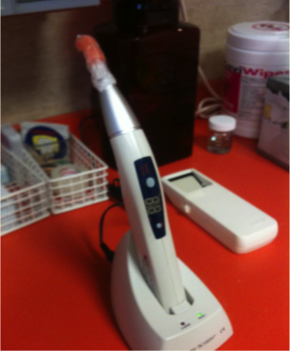دستگاه لایت کیور (Light Cure)
در کاربردهای پر کردن دندان ، پس از قرار دادن کامپوزیت ( مواد ترمیمی هم رنگ دندان ) در دندان ، دستگاهی
با نام دستگاه لایت کیور جهت سفت کردن کامپوزیت مورد استفاده قرار می گیرد.
دستگاه لایت کیور با بهره گیری از نور ماوراء بنفش منجر به تراکم و فشرده شدن سریع کامپوزیت می شود.
اساس کار انواع لایت کیورها نسبتاً متفاوت است. در برخی از انواع آن ها منبع تولید نور یک لامپ هالوژن می
باشد، در حالی که در برخی دیگر از LED برای سفت کردن کامپوزیت ها استفاده می شود.
مزیت LED نسبت به هالوژن
مزیت LED نسبت به هالوژن این است که نیازی به خنک کنندگی نخواهد داشت. میزان قدرت لایت کیور بر
حسب میلی وات بر سانتی متر مربع می باشد که بیان گر مقدار توان اشعه وارد شده بر واحد سطح است و
هرچه این نیرو بیشتر باشد، مدت زمان مورد نیاز جهت تابش کاهش می یابد.
در برخی از مدل ها که دارای توان فوق العاده بالایی می باشند، برای عمل سفید کردن دندان نیزمی توان از
این دستگاه استفاده نمود.
در دستگاه لایت کیور همیشه میزان تابش یکسانی مورد نیاز نیست و دندان پزشک نیز می تواند برحسب نیاز
خود تابش های متفاوتی را انتخاب نماید.
مهم ترین و رایج ترین انواع تابش در لایت کیور عبارتند از :
1)تابش ثابت که در طول نور دهی با شدت ثابتی تابید می شود.
2)تابش پالس که شدت نور کم و زیاد می شود و این افزایش و کاهش شدت ، کاملاً متناوب است.
3)تابش Ramp که از یک شدت نور کم شروع به تابش می کند و به تدریج و با افزایش زمان شدت نور زیاد می
شود.
در برخی از دستگاه های اتوماتیک با انتخاب شدت نور زمان نور نیز به صورت متناسب تنظیم می شود. در لایت
کیورهایی که دارای لامپ هالوژن هستند، برای خنک کردن از فن و یا از هوای کمپرسور استفاده می شود.
Dental curing light
A dental curing light is a piece of dental equipment that is used for polymerization of light cure resin
based composites.
It can be used on several different dental materials that are curable by light.
The light used falls under the visible blue light spectrum. This light is delivered over a range of
wavelengths and varies for each type of device.
There are four basic types of dental curing light sources: tungsten halogen, light-emitting
diodes (LED), plasma arcs, and lasers. The two most common are halogen and LEDs.
Tungsten halogen curing lights
The tungsten halogen curing light, also known as simply “halogen curing light” is the most frequent
polymerization source used in dental offices.
In order for the light to be produced, an electric current flows through a thin tungsten filament,
which functions as a resistor.
This resistor is then “heated to temperatures of about 3,000 Kelvin, it becomes incandescent and
emits infrared and electromagnetic radiation in the form of visible light”.
For provide
It provides a blue light between 400 and 500 nm, with an intensity of 400- 600 mW cm−2. This type
of curing light however has certain drawbacks, the first of which is the large amounts of heat that
the filament generates.
This requires that the curing light have a ventilating fan installed which results in a larger curing
light.
The fan generates a sound that may disturb some patients, and the wattage of the bulb is such (e.g.
80W) these curing lights must be plugged into a power source, that is, they are not cordless.
Furthermore, this light requires frequent monitoring and replacement of the actual curing light bulb
because of the high temperatures that are reached.
(For example, one model uses a bulb with an estimated life of 50 hours which would require annual
replacement, assuming 12 minutes’ use per day, 250 days per year.) Also, the time needed to fully
cure the material is much more than the LED curing light.
Light emitting diode curing lights
These curing lights use one or more light-emitting diodes [LEDs] and produce blue light that cures
the dental material. LEDs as light-curing sources were first suggested in the literature in 1995.
A short history of LED curing in dentistry was published in 2013.This light uses a gallium nitride-
based semiconductor for blue light emission
A 2004 article in the American Dental Association’s journal explained, “In LED’s, a voltage is applied
across the junctions of two doped semi- conductors (n-doped and p-doped), resulting in the
generation and emission of light in a specific wavelength range.
By controlling the chemical composition of the semiconductor combination, one can control the
wavelength range.
Dental LED curing
The dental LED curing lights use LED’s that produce a narrow spectrum of blue light in the 400- to
500-nm range (with a peak wavelength of about 460nm).
which is the useful energy range for activating the CPQ molecule most commonly used to initiate the
photo-polymerization of dental monomers.”
These curing lights are very different from halogen curing lights. They are more lightweight, portable
and effective.
The heat generated from LED curing lights is much less which means it does not require a fan to
cool it. Since the fan was no longer needed, a more lightweight and smaller light could be designed.
The portability of it comes from the low consumption of power. The LED can now use rechargeable
batteries, making it much more comfortable and easier to use.
Newest LED
The newest LED curing light cures material much faster than halogen lamps and previous LED curing
lights.
It uses a single high-intensity blue LED with a larger semiconductor crystal.
Light intensity and the illumination area has been increased with an output of 1,000 mW/cm2.In
order to emit such a high intensity light, it uses a highly reflective mirror film consisting of
“multilayer polymer film technology similar to photonic lattice LEDs.”




